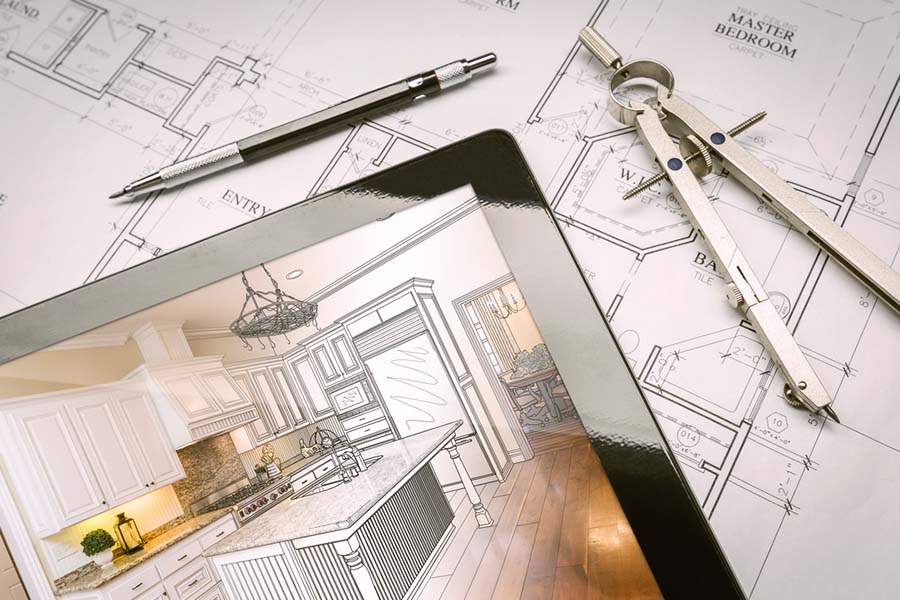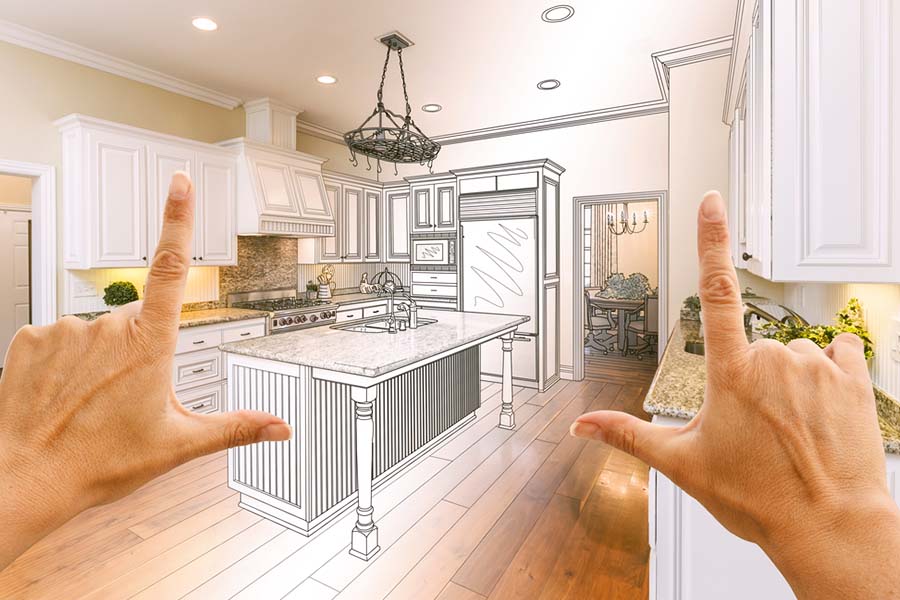How to Plan a Home Renovation

Are you eager to transform your living space? A well-planned renovation can breathe new life into your abode. But where do you begin this exciting yet daunting process of home renovation? Launching a renovation without proper planning is a recipe for disaster. So, how to plan a home renovation for a seamless process?
From setting realistic budgets to obtaining necessary permits, there are countless factors to consider before lifting a hammer. This comprehensive guide will walk you through every step, ensuring your renovation journey is smooth and stress-free.
We’ll explore strategies for defining your project scope and vision. You’ll learn how to assemble the right team of professionals and navigate the intricate world of design and construction.

How to Plan a Home Renovation?
There are many things that go into planning a home renovation. While it may seem especially stressful at first, proper planning based on your goals and budget can help you take off the burden. Planning a home renovation involves defining goals, setting a budget, and gathering ideas. Prioritize renovations based on goals and budget. Consult professionals for advice and estimates.
Now that we’ve mentioned all the steps briefly, let’s get into detail what each step entails.
Setting Realistic Goals
Before starting your renovation, take a step back, create a realistic timeline, and plan for any disruptions. Disruptions are bound to happen, so it’s best to be wary of them and expect them rather than stressing out when some plans take a left turn. Ensure that you obtain all necessary permits beforehand.
You could order your materials in advance and prepare your home for the upcoming work.
Before you take on the renovation project, set realistic goals of what you want to achieve with the renovation. Are you purely renovating to enhance the aesthetic appeal of your curb or to increase your home value, or is it a combination of the two? If you plan to increase the home value, though, be sure to make changes that will add significant value to your home compared to what you’ll spend.
Researching Renovation Ideas
Researching renovation ideas is a crucial step in embarking on a successful home improvement project. It involves gathering inspiration from various sources such as magazines, websites, social media platforms, home shows, and open houses. Today, with everything being just a click away, many seek inspiration on various social media platforms, with Pinterest being the most commonly used platform for home and style inspiration.
Explore different renovation styles and trends from traditional, modern, transitional, sustainable, and eco-friendly; there are definitely plenty of styles to choose from. Or you could go with a mix of two style options. You just need to go with the one that resonates with your idea of a perfect home.

Budgeting for Renovation
How to budget for home renovation? Budgeting for a renovation project involves several steps. First, establish a realistic budget by assessing your financial situation and determine which renovation goals to prioritize. Once’ve got an idea of just how much you are willing to spend, allocate funds accordingly. Finally, include a contingency fund for unexpected expenses.
Accurately estimating costs is critical at this stage. Do you plan to take on a major renovation process, or do you just want to make minor changes? If you undertake a large renovation, don’t underestimate the time period until you can finally call your home– a home. It could take you from a few months to a year. In some situations, even longer than a year.
If additional funding is needed, explore financing options such as home equity loans, personal loans, credit cards, and so on, or look into government-backed renovation loans or grants.
Meticulously track expenses throughout the process by maintaining a detailed spreadsheet or utilizing budgeting apps. Regularly review spending to adjust plans if necessary and implement cost-saving strategies during your renovation project.
If you think you budget cannot cover all the planned expenses, you can do some work yourself to save money. Or you could source materials at discounted prices. Refurbishing or repurposing existing fixtures and furniture can also stretch your budget further.
Hiring Professionals
How to plan a major home renovation? Hiring the right professionals is crucial for a successful renovation project as they bring expertise, and experience. A fresh perspective is always welcome. Consulting with professionals such as architects, interior designers, and contractors is also essential to get a hold of what the renovation process will entail.
Hiring professionals who deal with permits and regulations related to hiring professionals is essential. They can streamline the process and ensure compliance with building codes. Moreover, understanding these regulations can help you avoid costly fines or legal issues. Actively managing the renovation process is essential.
This involves regular walkthroughs and addressing concerns promptly. Maintaining open communication with your team of professionals is also crucial. It helps ensure the project unfolds according to your expectations while benefiting from their professional guidance.
Planning the renovation timeline
Creating a realistic timeline for a renovation project requires several steps. First, research average durations for similar projects. Second, consult with professionals to gather insights and expertise.
It’s crucial to build buffer time for potential delays caused by factors such as weather conditions, material shortages, or unforeseen structural issues. Maintaining flexibility in the timeline and being prepared to adjust it as needed through open communication with contractors is also essential.
When creating the timeline, consider temporary living arrangements or work zones. This helps separate construction areas and manage disruptions. Communicate anticipated disruptions to family, neighbors, or community associations. This fosters cooperation and manages expectations effectively.
Procuring Materials and Supplies
Procuring materials and supplies starts with creating a detailed list of consulting contractors/designers. Research and source from local suppliers, hardware stores, and specialty retailers – explore independent vendors for unique options. Shop around comparing prices and quality – read reviews and ask for samples.
Order materials well in advance, especially specialty items with longer lead times. Coordinate delivery schedules with contractors and follow manufacturer instructions.
Incorporate sustainable practices by using eco-friendly, recycled, or reclaimed materials and energy-efficient appliances and finishes. This reduces your environmental impact and may qualify you for green building incentives or tax credits.
Preparing Your Home for Renovation
Declutter and remove unnecessary items from work areas. Protect non-renovated spaces by covering floors, walls, and furniture, and consider relocating valuables to prevent damage.
Minimize disruptions by staying elsewhere during major construction phases or designating separate living areas away from the work zone. Set up a temporary kitchen/bathroom if renovating those spaces. Communicate with neighbors about upcoming work, noise, and disruptions.
Before starting demolition, ensure safety and security: discuss protocols with contractors, secure work areas, and provide protective equipment. Obtain necessary permits for dumpsters/heavy equipment. Implement security measures like temporary fencing and securing entry points.
Managing the Renovation Process
Open communication with contractors is essential. Schedule regular check-ins and progress meetings and address concerns promptly. Remain actively involved through site visits, monitoring progress, conducting quality inspections, and ensuring adherence to plans.
Be prepared to handle change orders and unexpected expenses. Carefully review and approve changes, or consider alternative solutions if the budget or timeline is significantly impacted. Maintain positive working relationships throughout the process.
As the renovation nears completion, conduct thorough final inspections. Create a punch list of outstanding items and deficiencies, and ensure all issues are addressed to meet your expectations and standards.

Completing the Renovation
Conduct a final walkthrough, carefully inspecting every aspect to make sure you are satisfied with the finished work. Once you’ve ticked all the boxes from your checklist, you are done with the renovation project.
Another thing is to thoroughly document the process. Take before and after photos, keep records of contracts, invoices, warranties, and permits.
Create a comprehensive project summary tracking progress, and store digital files securely for future reference or providing detailed information to potential buyers.
Conclusion
Breathe easy, your dream renovation is within reach! This guide has equipped you with the knowledge to navigate every step, from meticulous planning and budgeting to securing permits and conducting a final walkthrough. How to plan a home renovation?
Remember, thorough preparation and attention to detail are key. By following these steps and documenting the process meticulously, you’ll minimize surprises and ensure a beautiful, functional space that adds value to your home.
Don’t be afraid to tackle unforeseen challenges – with a well-thought-out plan and open communication with your contractor, you can navigate them smoothly. Now that you’re armed with this knowledge, go forth and create the home of your dreams! Happy renovating!
